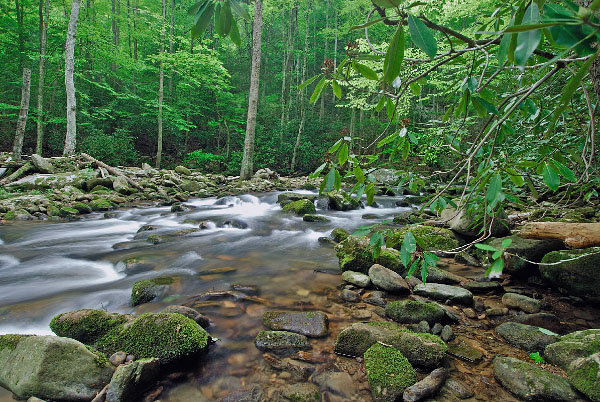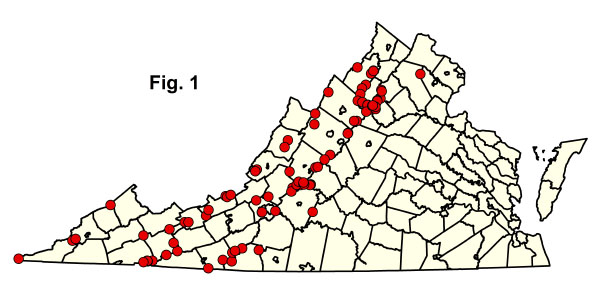

Virginia Department of Conservation and RecreationAn official website of the Commonwealth of Virginia Here's how you knowAn official websiteHere's how you know

Virginia Department of Conservation and RecreationAn official website of the Commonwealth of Virginia Here's how you knowAn official websiteHere's how you know
 Department of Conservation and Recreation
Department of Conservation and Recreation
 Table of Contents
Table of ContentsAcidic Cove Forests
This group contains mixed hardwood and hardwood-hemlock forests of infertile, mesic, montane habitats. In Virginia, these forests occur extensively throughout the mountains and rarely in the foothills of the western Piedmont, occupying moist lower slopes, ravines, and coves underlain by sandstone, quartzite, granite, and other acidic bedrock. Typical overstory trees include tulip-tree (Liriodendron tulipifera), eastern hemlock (Tsuga canadensis), red maple (Acer rubrum), sweet birch (Betula lenta var. lenta), eastern white pine (Pinus strobus), cucumber magnolia (Magnolia acuminata), and Fraser magnolia (Magnolia fraseri) in variable mixtures. Although less frequent, American beech (Fagus grandifolia) is also an important overstory tree in some stands, particularly in the Cumberland Mountains.
Dense, evergreen shrub layers of great rhododendron (Rhododendron maximum) are characteristic, although spotty in northwestern Virginia and largely absent from the northern Blue Ridge. On the southern half of the northern Blue Ridge, Catawba rhododendron (Rhododendron catawbiense) is often abundant on sites where great rhododendron is scarce. Other frequent shrubs include mountain laurel (Kalmia latifolia), witch hazel (Hamamelis virginiana var. virginiana), maple-leaf viburnum (Viburnum acerifolium), and mountain pepper-bush (Clethra acuminata, in southwest Virginia only). Herbaceous species, limited by dense shade and poor soils, are sparser and less diverse than in fertile cove habitats. Nevertheless, some Acidic Cove Forests have an "evergreen-lush" herb layer, with species such as galax (Galax urceolata) and Christmas fern (Polystichum acrostichoides) forming large colonies. The small orchid Appalachian twayblade (Listera smallii) frequently grows in deep shade under rhododendrons in these communities.
Composition of these forests appears to vary with elevation and physiographic region. They are closely related to communities of the Eastern Hemlock - Hardwood Forests ecological group, but generally have more diverse composition of woody species and considerably higher species richness. The hemlock component has been heavily reduced by past logging and, more recently, by outbreaks of the hemlock woolly adelgid (Adelges tsugae), an introduced insect pest.
References: Stephenson and Adams (1991), Coulling and Rawinski (1999), Fleming and Coulling (2001), Fleming and Moorhead (1996), Fleming and Moorhead (2000), Rawinski et al. (1996).
Click here for more photos of this ecological community group.
 © DCR-DNH, Gary P. Fleming.
© DCR-DNH, Gary P. Fleming.

 Download a spreadsheet of compositional summary statistics (Excel) for each of the community types listed below.
Download a spreadsheet of compositional summary statistics (Excel) for each of the community types listed below.

